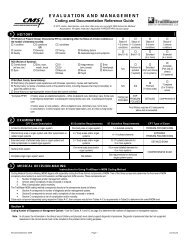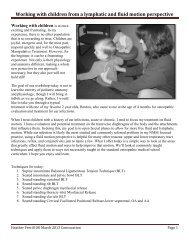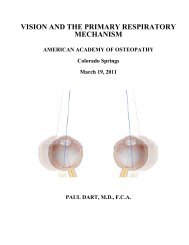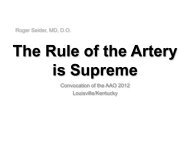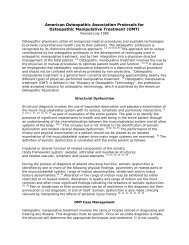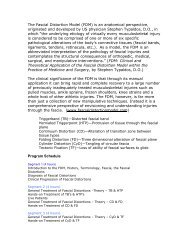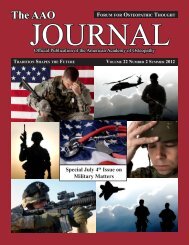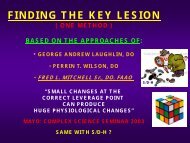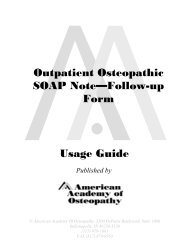Primary and Secondary Respiration - American Academy of ...
Primary and Secondary Respiration - American Academy of ...
Primary and Secondary Respiration - American Academy of ...
- No tags were found...
Create successful ePaper yourself
Turn your PDF publications into a flip-book with our unique Google optimized e-Paper software.
<strong>Primary</strong> <strong>and</strong> <strong>Secondary</strong> <strong>Respiration</strong>Raymond J. Hruby, DO, MS, FAAO
Objectives• Define:• <strong>Primary</strong> Respiratory Mechanism (PRM)• <strong>Secondary</strong> Respiratory Mechanism(SRM)• Discuss Relationships Between PRM <strong>and</strong>SRM• How are they related?• Where do they meet?• What is the clinical significance <strong>of</strong>this interrelationship?
<strong>Primary</strong> Respiratory Mechanism• <strong>Primary</strong> –underlying all other physiologicfunctions• Respiratory –concerned with cellularrespiration• Mechanism –cranial articulations <strong>and</strong>sacral respiratory motion bt between theilia
Anatomy <strong>and</strong> Physiology <strong>of</strong> the PRM• Structural components:• Cranial articular mechanism• Intracranial <strong>and</strong> intraspinal membranes• Sacrum• Functional components:• CSF• Inherent motion <strong>of</strong> the CNS• Inherent potency
StructureReciprocalTensionMembraneCSFFluctuationCranialArticularMobility<strong>Primary</strong>RespiratoryMechanismSacralRespiratoryMotionCNSMotilityOSTEOPATHICSTRUCTURALEXAMFunction
<strong>Secondary</strong> Respiratory Mechanism(SRM)• SECONDARY – dependent on the PRM• RESPIRATORY –concerned with alveolarrespirationi• MECHANISM – includes anatomic structuresfrom nasal passages to alveoli; li also includesrib cage <strong>and</strong> diaphragms
Anatomy <strong>and</strong> Physiology <strong>of</strong> the<strong>Secondary</strong> Respiratory Mechanism(SRM)• Structural components– Nasal passages– Pharynx– Larynx– Bronchi– Lungs– Thoracic cage– Diaphragms: throracoabdominal, pelvic,cranial
Anatomy <strong>and</strong> Physiology <strong>of</strong> the <strong>Secondary</strong>Respiratory Mechanism (SRM)• Functional components:• Concerned with thoracic (alveolar)respiration• O 2 – CO 2 transfer mechanism• Intimately connected to other bodysystems such as cardiovascular,neurological, musculoskeletal
Commonalities Between the Two Systems• Vital to life• Phasic in nature• Respond to metabolicdem<strong>and</strong>s
Some Possible PRM-SRM Relationships• Both have spontaneous excursions• Can be in or out <strong>of</strong> phase with each other• They can move in an unrelated ltdfashion, withthe PRM typically slower• SRM can enhance PRM or assist withtreatment <strong>of</strong> PRM – for example, use <strong>of</strong>respiratory cooperation
Some Possible PRM-SRM Relationships• The PRM is constant <strong>and</strong> stable• The SRM is more prone to modulation <strong>and</strong>adaptation to the environment• The SRM adjusts to the external atmosphericconditions to meet the needs <strong>of</strong> the internalmetabolic processes, including the PRM.
Some Possible PRM-SRM Relationships• Restriction <strong>of</strong> motion <strong>of</strong> cranial bones,<strong>and</strong>/or cranial, thoracic <strong>and</strong> pelvicdiaphragms can alter PRM amplitude <strong>and</strong>frequency• SRM can be used to influence PRM
Some Possible PRM-SRM Relationships• The PRM continues as long as life persists• The SRM may be interrupted t or stopped,<strong>and</strong> resumed through forcefulmanipulation <strong>of</strong> the temporal bones
An Interesting Analogy?• The PRM may be compared to the rise<strong>and</strong> fall <strong>of</strong> the oceanic tide• The SRM may be thought <strong>of</strong> as the waves<strong>of</strong> the ocean water that arise from <strong>and</strong>respond to environmental changes
Where do the PRM <strong>and</strong> SRM meet?• Some examples:– Temporal bones– Occiput <strong>and</strong>/or Sacrum– Neurological control system for respiration– The core link <strong>and</strong> the three diaphragms
Where do the PRM <strong>and</strong> SRM meet?• PRM initiates <strong>and</strong> maintains activity <strong>of</strong> CNSrespiratory centers.• These CNS centers then di drive the action <strong>of</strong> theSRM components.• Provides a “pathway” for the influence <strong>and</strong>action <strong>of</strong> the inherent potency <strong>of</strong> the PRM.
Temporal Bones
Temporal Bones
Occiput <strong>and</strong> Sacrum
Connection to the Neurological System
Neural Control <strong>of</strong> <strong>Respiration</strong>
Connection to the Musculoskeletal System
The Core Link <strong>and</strong> the Three Diaphragms
What is a Diaphragm?• A connective tissue septum which divides abody cavity into superior <strong>and</strong> inferiorcompartments.• This septum is attached at its periphery to amobile part <strong>of</strong> the bony skeleton <strong>and</strong> issubject to rhythmic motion related to thephases <strong>of</strong> respiration.
Cranial DiaphragmSuperior View <strong>of</strong> the Tentorium Cerebelli
Thoracoabdominal Diaphragm
Pelvic Diaphragm
Connection to the Cardiovascular System
ANOTHER THOUGHT…Consider the extensive nature <strong>and</strong> function <strong>of</strong> fascia
Another Thought• H. Langevin. Connective tissue: A body‐widesignaling network? Medical Hypotheses,Volume 66, Issue 6, Pages 1074‐1077.
Another Thought• Unspecialized ‘‘loose’’ connective tissue formsan anatomical network throughout the body.The hypothesis is that, in addition, connectivetissue functions as a body‐widemechanosensitive signaling network.
Another Thought• Three categories <strong>of</strong> signals are studied:electrical, cellular, <strong>and</strong> tissue remodeling, eachpotentially responsive to mechanical forcesover different time scales.
Another Thought• It is proposed that these types <strong>of</strong> signalsgenerate dynamic, evolving patterns thatinteract with one another.• Such connective tissue signaling would beaffected by changes in movement <strong>and</strong>posture, <strong>and</strong> may be altered in pathologicalconditions (e.g. local decreased mobility dueto injury or pain).
Another Thought• Connective tissue thus may function as apreviously unrecognized whole bodycommunication system.
Another Thought• Since connective tissue is intimately associatedwith all other tissues (e.g. lung, intestine),connective tissue signaling may coherentlyinfluence (<strong>and</strong> be influenced by) the normal orpathological function <strong>of</strong> a wide variety <strong>of</strong> organsystems.
Another Thought• Demonstrating the existence <strong>of</strong> a connectivesignaling network therefore may pr<strong>of</strong>oundlyinfluence our underst<strong>and</strong>ing <strong>of</strong> health <strong>and</strong>disease.
A. T. Still on fascia:• “This connecting substance must be free at all partsto receive <strong>and</strong> discharge all fluids, <strong>and</strong> use them insustaining animal life, <strong>and</strong> eject all impurities, thathealth may not be impaired by dead <strong>and</strong> poisonousfluids.”• “By its action we live <strong>and</strong> by its failure we die.”• “The soul <strong>of</strong> man, with all the streams <strong>of</strong> pure livingwater, seems to dwell in the fascia <strong>of</strong> his body.” body”
Clinical Correlations• Deep inhalation (SRM) can enhance the PRM– Newborn first breath• Biomechanical factors –Exercise: try breathing withneck extended vs. flexed• Realignment <strong>of</strong> core link elements (diaphragms)• Temporal lbone influence on respiration• CV4 technique• Sutherl<strong>and</strong>’s (<strong>and</strong> others’) experience withrespiratory arrest patient
Breath <strong>of</strong>LifePRMSRM
<strong>Primary</strong> vs. <strong>Secondary</strong> <strong>Respiration</strong>PRM• Inherent motility <strong>of</strong> the brain<strong>and</strong> spinal cord• Fluctuation <strong>of</strong> thecerebrospinal fluid (potency)• Mobility <strong>of</strong> the intracranial <strong>and</strong>intraspinal membranes• Articular mobility <strong>of</strong> thecranial bones• Involuntary motion <strong>of</strong> thesacrum between theinnominatesSRM• Structural components– Nasal passages– Pharynx– Larynx– Bronchi– Lungs– Thoracic cage– Diaphragms: throracoabdominal,pelvic, cranial– Respiratory centers in the brain• Functional components:• Concerned with thoracic (alveolar)respiration• O 2 –CO 2 transfer mechanism• Intimately connected to other bodysystems such as cardiovascular,neurological, musculoskeletal
PHYSIOLOGICFUNCTIONS…
Physiologic Functions• <strong>Respiration</strong>– Clll Cellular– Tissue• Fluid Exchange– Arterial blood– Venous blood– Lymph– Cerebrospinal fluid
References• Moskalenko, Y. Cerebral pulsation in the closedcranial cavity, Izv Asad Nauk SSSR (Biol) 4:620‐9, 61.• Sears. Investigations on respiratory motoneurones <strong>of</strong>the thoracic spinal cord, Progr Brain Res 12:259‐72,64• Nelson eso KE et al.2001 a. Cranial Ca arhythmic impulserelated to the Traube‐Hering‐Mayer oscillation:comparing laser‐Doppler flowmetry <strong>and</strong> palpation. p JAm Osteopath Assoc, 101(3): 163‐73




